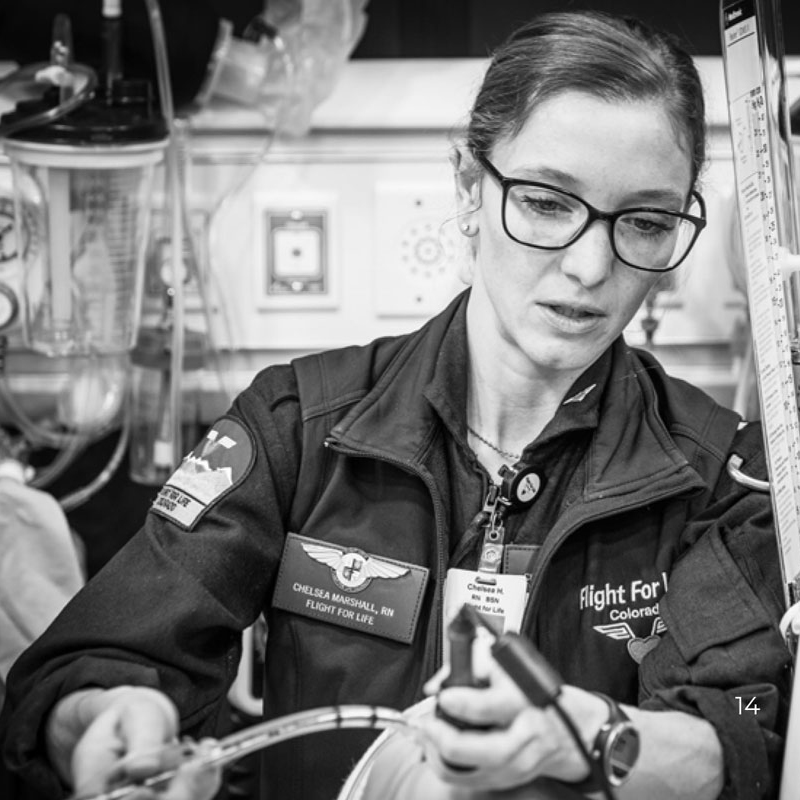A Matter of Life or Death
Flight for Life Simulator Provides Unprecedented Training for Crew Members
An 80-year-old man lays on a stretcher at St. Anthony Summit Medical Center. He has trauma to his head after falling while shoveling snow. The team treating him, Flight For Life nurse Chelsea Marshall and her partner Flight Paramedic Chad Miller, are preparing the patient for transport to Denver when things suddenly deteriorate.
“He needs to be intubated,” Chelsea says, and wedges herself between the wall and the patient’s head and Chad prepares the intubation tube. Intubation is a common procedure in operating rooms, but less so in the field. The delicate process of threading an endotracheal tube into the patient’s airway is challenging and risky; the more attempts that are made, the more the risk increases. “One small slip and I could do serious damage,” Chelsea whispers.
This isn’t any ordinary rural hospital room. And the patient is not an ordinary patient. Chelsea is working with a high-tech human robot through a training scenario unfolding inside the St. Anthony Flight For Life simulator that was purchased with funds raised by the Foundation’s annual golf classic at the Sanctuary golf course.

On the other side of a wall, watching her movements on a closed-circuit monitor, is Brian Hendrix, Chief Flight Nurse and Operations and Clinical Simulation Coordinator for Flight For Life. “I’m the wizard behind the curtain,” Brian chuckles as he sits at the control center in his blue flight suit. “I control all the patient’s vital signs and can make things change in a heartbeat. I can talk on behalf of the patient through a microphone and have real-time conversations with the nurses. If the patient is a child or a woman, I can even synthesize my voice.”
The entire program, including the custom-made trailer, and a F-450 Ford pickup for towing, cost $800,000. It is the only one of its kind in the United States and the envy of flight programs across the country. The trailer fills a need in training flight crews. It’s a way to manage risk in health care, Brian says. “There are many medical procedures where training is critical and not all of them happen in the big operating rooms. The trailer allows us to give every team member the opportunity to practice those once-in-a-lifetime procedures. This kind of high-fidelity training prevents errors and mistakes from ever getting to our patients.”
Since Flight For Life crews are almost always working in ever-changing and cramped quarters, the simulator is able to replicate those as well. “We can set it up to be a rural emergency room like this one, an ambulance, a helicopter and even an airplane. Everything is flexible.”
There are many medical procedures where training is critical and not all of them happen in the big operating rooms. The trailer allows us to give every team member the opportunity to practice those once-in-a-lifetime procedures.
—Brian Hendrix, Chief Flight Nurse and Operations and Clinical Simulation Coordinator for Flight For Life
Brian had to get his commercial trucking license to drive the 54-foot rig around. Today the trailer is parked outside of St. Anthony Hospital, however, it goes on tour every three months to train flight paramedics and nurses all over Colorado. “Before we had the trailer, I had to haul equipment around hospital to hospital. Now the trailer is dedicated equipment.”
Back behind the curtain, Brian watches as Chelsea finishes up her scenario. He takes his headphones off and starts processing the video. “Not too long ago we were training crews for a case that involved a child with severe asthma,” he says. “And not a week later, one of the nurses flew to Aspen to treat a very sick kid with asthma. They had to intubate him on the flight.” Did the training work? “It paid off,” Brian says, smiling and leaning back in his chair. “They knew what they were doing and they saved that child’s life.”